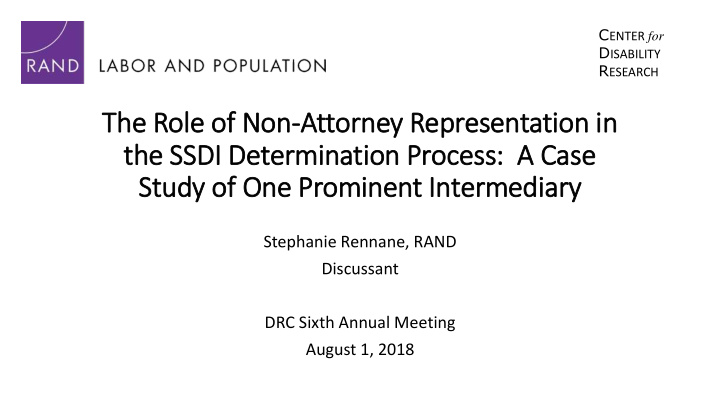



C ENTER for D ISABILITY R ESEARCH The Role of f Non-Attorney Representation in in the SSDI I Determination Process: : A A Case Study of f One Prominent In Intermediary ry Stephanie Rennane, RAND Discussant DRC Sixth Annual Meeting August 1, 2018
Non-Attorney Representation in SSDI: Context • SSDI application process is long and complex • Transaction costs affect participation (e.g., Armour 2018, Deshpande & Li 2018, Foote, Grosz & Rennane 2018) • Representation very common for hearings and appeals • Representation increasing at the initial stage (GAO 2014) • 2011 reforms to ALJ trainings (Hoynes, Maestas & Strand 2018) • Role of representation is not well understood
Non-Attorney Representation in SSDI: This Paper Several important contributions: • Description of the intermediary’s objectives, role and screening process • Obtain proprietary, administrative data on one intermediary’s potential clients • Data Analysis: • Who is eligible for, and who uses, non-attorney representation? • How do these applicants compare to the overall SSDI applicant pool?
Key Take-aways • Intermediary screening process emulates application screening process • Shift application burden earlier, but perhaps does not eliminate?
Key Take-aways • Intermediary screening process emulates application screening process • Shift application burden earlier, but perhaps does not eliminate? • Clients (of this intermediary) are older, have larger benefits, more likely to have musculoskeletal issues • How does the population compare with those served by other representatives?
Key Take-aways • Intermediary screening process emulates application screening process • Shift application burden earlier, but perhaps does not eliminate? • Clients (of this intermediary) are older, have larger benefits, more likely to have musculoskeletal issues • How does the population compare with those served by other representatives? • Most clients (of this intermediary) are also eligible for LTDI • Shifts in costs from private sector to public sector? • To what extent does employer facilitate application? • Autor, Duggan, Gruber (2014): 1/3 of civilian workers are eligible for LTD
A wish list.. • Would love to know more about : • Geography ? • LTDI from particular industries? • Firm size, age? • Only SSDI, or other benefits/services? • Advertising & outreach – with individuals or employers? • Any sense on the number of other players in this space, and/or if they have similar clientele?
Ideas for the future • LTDI implies this is likely a more affluent and potentially better educated sample. At the very least, better insured. • Anything we can imply to the broader SSDI population? • Comparison to attorney representatives. Who chooses which type of representative, and when? • Look at trends over time, across states, etc
Implications for applicants and policy • What do applicants know about the cost & likelihood of success, and when do they know it? • Could have implications for the decision to hire, and more broadly, to apply • What do we know about duration of application process? • Shifting costs between private individuals, private sector and federal government (if mostly LTDI?) • Trade offs between benefits and costs to applicants, society
Recommend
More recommend